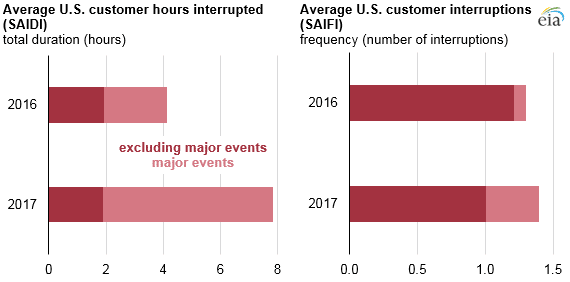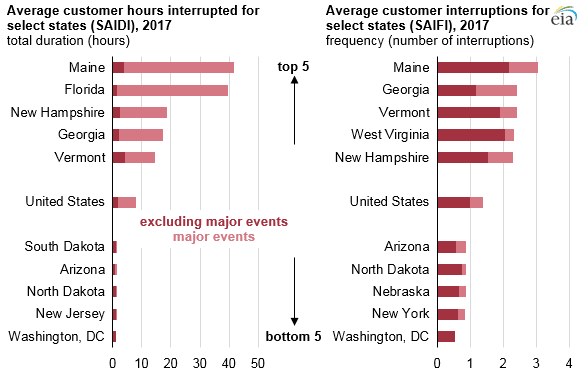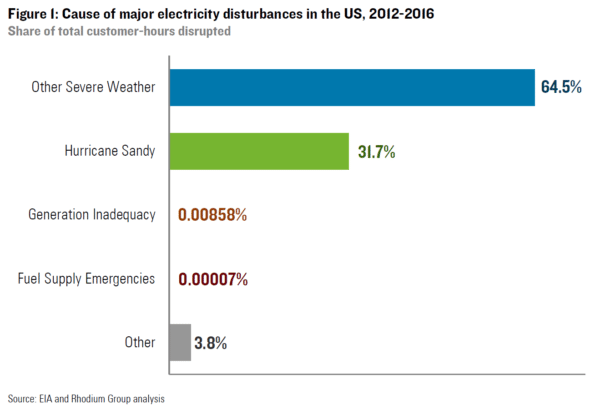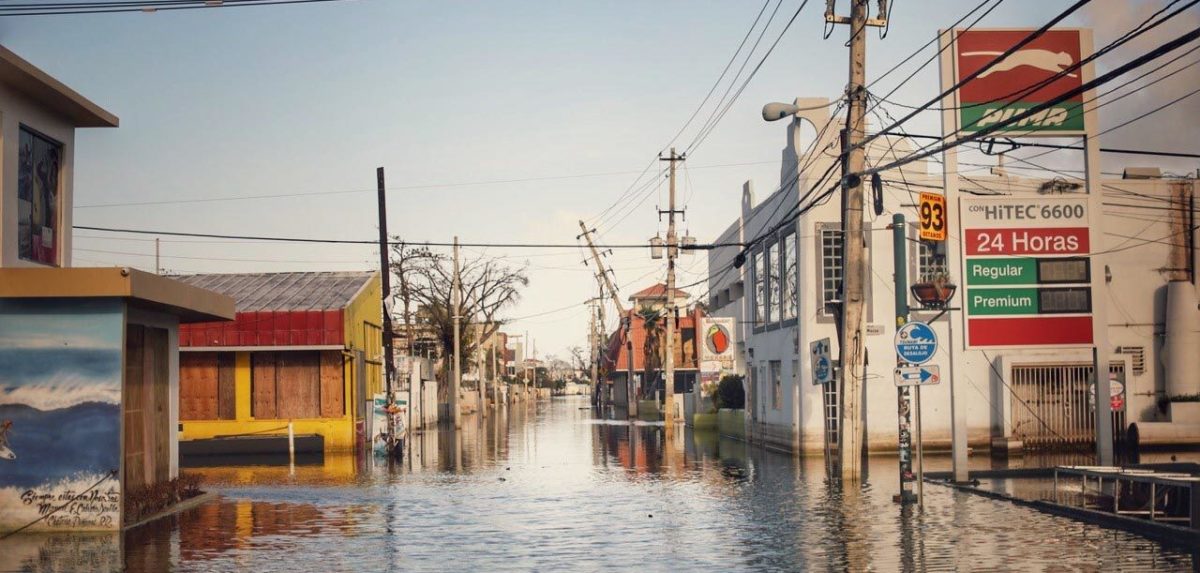If you look at the mission statement of any electric utility, one word will come up again and again: reliability. Providing a stable supply of electricity is a core part of the mission of all utilities, and is demanded by the regulators who oversee them.
And yet the security of U.S. electricity supply, which has long lagged that of other highly developed nations, appears to be getting worse. In an analysis released last November, the U.S. Department of Energy’s Energy Information Administration (EIA) reported that the average hours of interrupted service for U.S. electricity customers nearly doubled from 2016 to 2017.

The culprit was clear: more “major events”, many of which were weather-related disasters on the East Coast. In fact, the five states with the highest number of hours of interruption were all in New England and the Southeast, and all were battered by storms during the year.

Notably, this analysis did not include Puerto Rico, where Hurricane Maria caused the greatest power outage to date in the United States. And if anything this trend continued in the continental United States in 2018, with Hurricane Florence knocking out power in much of the Carolinas, and power shutoffs in advance of wildfires in California.
It’s not hard to extrapolate from the warnings of climate scientists that an increasing frequency and severity of weather events and other natural disasters is likely going to be interrupting our power supply, and that this will only get worse.
Missing tools in the toolbox
While the U.S. Department of Energy under Secretary Perry has emphasized on-site fuel supplies as a means to support reliability (which many have observed is more a way to bail out uncompetitive nuclear and coal plants), lack of on-site fuel is responsible for a statistically insignificant portion of power outages. In fact, as explored in this analysis by Rhodium Group, the overwhelming majority of major grid failures are caused by the failure of power lines, not power plants.

This includes the power lines which supply electricity to large generators. This was illustrated when Entergy was forced to shut off its Pilgrim nuclear power plant in Massachusetts during a severe winter storm last January due to downed lines, and also when many large solar plants in North Carolina were unable to supply power during the flooding that followed Hurricane Florence.
Not only can rooftop solar and batteries supply backup power in the event of an outage, but distributed generation has the advantage of being closer to demand, and can improve the reliability of the grid. Microgrids further enhance this advantage, and are being actively investigated by a number of cities including New York as a means to protect critical infrastructure during disasters.
Conflict of interest
While distributed generation and storage can offer significant reliability advantages, with a few notable exceptions such as Green Mountain Power’s roll-out of Tesla batteries for its customers in Vermont, utilities are not pursuing this option.
And while utilities tend to be more favorable to batteries, they have waged all-out war on rooftop solar, through both attempting to dismantle net metering policies and through changing rate structures in ways that undermine the economics of the PV systems their customers would install.
For investor-owned utilities the reason is clear: net metered customer- and third-party owned solar is a direct threat to their business model, and Edison Electric Institute has stated as such. And despite the requirements of regulators, like any corporation the first responsibility of the leadership of investor-owned utilities is to their shareholders.
However, as steady supply of electricity is a precondition of our modern society and as the frequency and intensity of severe weather events is only going to increase, something is going to have to give.
This content is protected by copyright and may not be reused. If you want to cooperate with us and would like to reuse some of our content, please contact: editors@pv-magazine.com.









DG is clearly the answer to the reliability problem. Sunnova’s CEO Berger contsantly touts it. FEMA just endorsed it. Enphase microinverters are the solution which provide reliability, safety and longevity. Big solar farms out in the middle of nowhere may be better than nuclear, coal, and other fossil fuels, but still the transport of that electricity to the distributed loads is a problem. DG is the only answer, and the latest bouts of hurricanes over the past few years has proved it enough, that even FEMA endorsed DG and microinverters. Price is no longer an issue; in fact, if you add initial, BOS, and O&M costs, solar+ storage are highly competitive or even a better choice. I am waiting for Enphase’s Encharge storage; with 4 IQ8 micros integrated, they will bring reliability to storage, as they have for solar PV. Can’t wait for IQ8!
Do not discount the threat of reliability to regulated grids and coops. The monopoly is granted because of reliability and cost and the argument is that solar is unreliable and expensive. Therefore if solar is MORE reliable and cost-effective AND being obstructed by the monopoly, the monpoly will fall in the name of.public health and safety…
I think Green Mountain Power is definitely on the right track, Power companys have the best potential to leverage distributed resources into the community. Offer it as a subscription plan. Solar + storage for grid back up for +9.95 a month. Couple in forced time of use rates to all you could make the battery be “insurance you don’t use much on peak power”. Or get the battery for 3.99 a month with a tou plan and you’ll save on average $5 a month….
I like the enphase iq8 units advertised features (I do own there stock) if it works as advertised it’s a game changer.
I think all new builds should require islanading solar or solar + storage. It’s just like insulation, the average home owner won’t do it with an ROI of over 5 years but for a structure that will last 30-50+ years it makes long term ecenomic sense. If it becomes code then the playing field is leveled out.
To get to this point though states or the Fed will have to mandate the change.
When are Enphase’s IQ8s and this slick smart battery system coming out? I heard they are being released to a select few installers as tests systems right now. Also heard that factory tests are were done. I also read SunRun Exec description of what he witnessed with the IQ8s demonstration in action. But the biggest question I have is, why is everything so hush hush on the IQ8s? Shouldn’t Enphase be at least showing to the public what’s coming? Or is there a reason for the delay? I keep hearing at the start of 2019 we will see more. That’s now!
Agreed. We are waiting for more details as well.